Your Planets
Portraits of the Planets
Aspects between Planets
The planetary ages
The planetary families
Planets in Signs
The Planets in comics


If we grant the imagination to the Moon, we must return the image to the Sun… and the image is to the eye what the eye is to the Sun: its image. As a role model, her power is extensive. It spreads, it generalizes. A model can change, be enriched, impoverished, become obsolete, but, for the time of its effectiveness, it sets the tone of a fashion or a thought, it governs the paradigms.
The R.E.T. is a model that is all the more solar in that it comes from the system of the same name. It comes from the planetary meanings. He was found thanks to them. It leads to new formulations but it has not manufactured those that already exist, and even less artificial attributions. If the majority of astrologers still refuse to understand that the R.E.T. is not a gratuitous invention but a model resulting from facts… this is due to the anti-publicity that is made of it by the supporters of other models. But if you know one who respects the traditional meanings and classical astro-psychology, it would be selfish to deprive research of it… and I mean research, because no model can be authoritative if it is not produced by the facts or if the facts do not confirm it.
The competition, normal between several models, is decided by experience. That is why Mars is at the center of the R.E.T., at the center of the centers. He judges what works… but as in astrology everything has a reputation for working… to make a selection of competitors, you have to know how many legs, how far and how far.
At the R.E.T. tri-level planetary for 9 major planets, it was easy to add a R.E.T. lunar, concentrating globally and in its unity all the planetary functions… a bit like white or black light contains the whole spectrum of colors. Rather than the colors, to make the difference of the two R.E.T. understandable, show their continuity, I use the cycle of phases.
The Moon alone contains them all. Hence his intensive power. In the R.E.T. extensive, there is only one phase per planet. This diagram is educational, it is necessary to replace phase by function. It is also analog, and makes it possible to understand that if the Moon is “global-homogeneous”, because of its link with the Earth, it cannot be detached from the solar system. Globality is not enough, as we have seen for the Mother who must ensure continuity, pass the baton to the Father. No one can flatter themselves to stay in the Moon. In any case, it leads to trouble.
According to a Babylonian hymn addressed to Sin, the Moon is “a fruit that grows by itself”… but the fruit comes from the Tree.
In the solar system, each planet, seen from the Earth, has its own phases and satellites. It is not forbidden to represent them inside each planetary box, as one can represent the orbit with apogee and perigee or indicate the position in Sign, in House, according to a suggestion by François Bourdillat. The R.E.T. exposed to Proceedings of the Astrology Colloquium and Spirituality where each square of the diagram is subdivided into 10, supports the indication of all aspects by their ideograms. This is all that the R.E.T. in a diagram that passes for rigid and dogmatic… and I am not talking about the search for the call function based on the symmetries and complementarities of the boxes.
Each planet has a function, an ability which amounts to giving this time to the word power the meaning of to be able to do, to be able to… The Moon then becomes the Lady of Doing… making homogeneity.
What differentiates the Sun, Mars, Pluto functions from the others is their situation as a self-reflective center (representation of Representation, ‘rR’ for the Sun ; existence of Existence, ‘eE’ for Mars ; transcendence of Transcendence, ‘tT’ for Pluto) which is more precisely designated by homeostasis (maintaining the same). The triad is known in less scholarly terms by the powers of King, Soldier, Sorcerer (or Priest).
▶ Sun: ‘rR’: the King, power of decision-representation
▶ Mars: ‘eE’: the Soldier, power of execution-realization
▶ Pluto: ‘tT’: the Priest, power of transvaluation-persuasion
Each center has its allies, its servants, its synergistic or antagonistic functions. But since there are common alliances… the three powers independent of each other are united by their alliances, all they have to do is confront, intimidate or associate to find a relative balance, which is generally unstable.
Whether or not the planets are dominant, the R.E.T. necessarily leads to the interpretation of the globality of the chart, therefore to that of the individual hierarchy and its interference with the hierarchy of the reference model.
Those who have followed my courses know all that can be obtained original, impossible in direct reading of the chart, by this method, unavoidable outcome of the premises posed in La Condition solaire.
those and those who refused to go all the way of the ordinal logic of R.E.T., while applying it on the sly, have separated themselves from conditionalism as I teach it, and I thank them for no longer encumbering a higher path of research.
On the ternary and power (noun), John Kenneth Galbraith, Emeritus Professor at Harvard University, former United States Ambassador to India, author of L’Anatomie du Pouvoir (Threshold), written:
“Power analysis lends itself quite well to the little game of ‘three’. There are three instruments to exercise it and three attributes or institutions confer the right to do so. We measure the insufficiency of the study of power by the absence of commonly accepted terms to designate its three instruments, which are nevertheless quite obvious. So let’s name them: they are deterrence, retribution and persuasion, or conditioning” (in the sense of dressage, it is me who specifies). “These three processes of exercising power flow from three sources—the attributes or institutions that distinguish those who wield power from those who submit to it. These three sources are personality, property (including, of course, disposable income), and organization.”
It will be easy to recognize, in the sources:
▶ Sun for personality
▶ Jupiter for the property
▶ Uranus for the organization
Without going around the various sensitivities to political powers, from anarchists to legalists… such as in itself, the solar power, when it is restrictive like a Witch-Mother, is that of the ambient models and paradigms which reign as despots over blissful flocks. We are all imbued with prohibitions “to do and not to do”, “to say and not to say” of socio-cultural life, the ideal domain of consensual solar power.
If you don’t understand the conditionalism it is because it is not in tune with the times and because the reigning astrology cannot prepare you for it. Galileo was not content to look at the sky with his telescope to see the phases of Venus which justified heliocentrism… He looked at the sky with the Copernican theories he knew… and he saw reality with its appearances thanks in the eyes of the Spirit, prepared and trained by his knowledge.
In this sense, the attribution Sun = Spirit seems correct and attractive. Except that this same Spirit, imbued with forbidden knowledge, idols and legitimate clichés, also prevents us from seeing the unknown of possible knowledge. We are bathed in political and scientistic models… which make astrologers (among other corporations) think like politicians because politics is fashionable. Similarly, because of the image of almost absolute objective authority that science has succeeded in giving of itself, few are those who are aware of the relations of scientism with totalitarian ideologies and with the excesses, moral deficiencies of modern world created by the successes of technologies above all metaphysics.
In terms of typologies, the self-reflexivity of Sun (‘rR’) was described by Frédéric Paulhan (1856–1931), philosopher and psychologist, in his work L’activité mentale et les éléments de l’Esprit (Ed. Alcan. 1889).
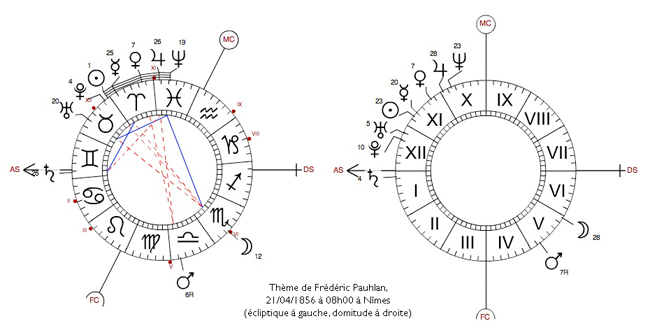
I quote: “There is no denying that the higher psychic forms have long been neglected by psychologists who tried to separate psychology from metaphysics…” (page 157). “The power of man to seize his natural capacities and to direct them, makes him a person. and it is because things do not exercise this power in themselves that they are only things” (page 159). “Voluntary attention, deliberation, will, reflective consciousness, are various forms of ‘personal power’” (page 170). “We have so far considered in personal power only reflection, but there is something more to examine, it is the decision, it is the moment when the belief is fixed, when the will is decided…” (page 171).
Paulhan associates reflection, self-reflection, personal power… and, consequently: decision, will, determination. A self-reflective sequence which, for us, can be reduced to the formula ‘rR’ of the Sun.
In the Caractères, in application of his first work, Frédéric Paulhan, draws up a gallery of portraits that one cannot appreciate or criticize validly without knowing well the theory which guides him. It differs considerably from current interpretation methods, and is closer to the synthetic interpretations advocated in “The Hero and his Shadow”. Given that the Moon contains all the functions, it relates to a variant of what Paulhan calls systematic association, and to the balanced types… a form of wholeness that Paulhan does not necessarily see from a flattering and dynamic angle: “One can be balanced in mediocrity as well as in genius, and naturally the first case is the most frequent. Eating, drinking, sleeping, seeing a few friends, going for a walk, or playing dominoes may be all there is to worry about. The balanced character borders (in this case) on the absence of character… We all know people who, without pleasing us by any high quality of heart or intelligence, nevertheless charm us by the grace of their life, by the freshness, by the harmony of their ideas, perhaps sometimes a little short and quite few in number, and of their feelings when they are good but without particular grandeur, especially when physical harmony and bodily grace come together to moral harmony and grace of spirit.” For F. Paulhan, mediocrity is a flat average.
When the balance tends towards perfection, it approaches the solar of theoretical astro-psychology. Paulhan doesn’t always seem to make a clear distinction between flat balance and top balance… In this he joins the Tradition which links the balance, neither to the Sun nor to the Moon… but to the relationship of the two… therefore to the couple King and Queen in a single body and soul, as expressed by the alchemical symbols.
The second series of types “systematized” includes, according to Paulhan, the “unified”… which themselves are closer to the solar function. To be “Unified” by a vocation, a key idea, an exclusive passion, it is sometimes necessary to add inhibition to systematic association. It is responsible for expurgating temptations, asides… and thus subordinating all the other functions to the dominant (pages 16 to 22).
When unity is conquered by a greater part of the effort of control than of naturalness, Paulhan speaks of types produced by the predominance of systematic inhibition… even more solar than the “Balanced-Unified” and, this time, close to the function “small r” (intensive representation). Types of this mode of organization of tendencies include according to Paulhan, the “masters of themselves” and the “Think”… Two qualities obtained at the cost of hard struggles between antagonistic tendencies… which now leads us to pass from the Sun-Moon couple (King and Queen) to the King’s relationship with the Warrior and the Sorcerer (relationship of the Legislative with the Executive and the Persuasive). If they are discordant, not subject to a common rule, therefore heterogeneous… we join the impulsive, the incoherent, the crumbled at the bottom of the scale of the Paulhan Types as far as the order or disorder of tendencies is concerned.
Whether through experience testing or through deductive reasoning, it is impossible to dissociate the elements of Heaven. We can prioritize them, order them but not isolate them. This is an undeniable astrometric reality that proponents of statistical methods should ponder thinking, as gardeners do “organic”, and as I do for my own garden, to crops “associated” (although a theoretician, I know how to plant cabbage and potatoes).
The conditionalist models of prioritization take into account all the planets, and if the interpretation can then neglect some of them, this will come from the demonstration of an analysis, as much as from the principle: “The horoscope is not the subject”, because according to the terrestrial baggage, there are dominants well or badly experienced.
If the powers are linked to the planets as to the ambitions, the centers must be so too… To know how, should one consult astronomy, physics, or symbolism?
On the side of contemporary symbolism, there is no question of linking the centers. Thus, I read, from the ink of a symbolist (1) very committed to the censorship of conditionalism, that the Sun should govern the heart because it was at the center of the solar system (2).
Unfortunate astrometric reference. The planetary orbits are not circles with a single center, but ellipses with a center and two foci, which a follower of the Black Moon should know. The Sun is not a center but a multi-center (the planetary masses, notably those of Jupiter and Saturn, each determine a “center of mass” which does not coincide with the geometric center). The Sun and the solar system revolve in 200 million years around another relative center: the nucleus of the galaxy. A center revolving around another no longer fits the image of a circle. That of several spirals, for the planetary movements, around an axis of which the Sun is the pole, would be better suited… to an elementary astronomy and to the symbolism of an arrow of fire, with the Sun at its point as at the top of the diagram R.E.T.… A prominent bull’s-eye position at the dome of a roof that I chose and defended against other possible choices.
The one who decides, directs, guides, opens the way, does not place himself in the center but before: he indicates the course… as a captain, heading meaning head, chief and not heart (3). The anatomical reference is hardly happier, except if it is a question of teratology, science of monsters, because it takes a special stomach to put the heart in the center of the body. The analog reference is incomplete; the Sun also governs the back which is not the vital center of the self… and I do not know to what intuitive we owe these relevant correspondences, the right eye, the spinal cord, the backbone are part of its attributions.
The eye directs the head which extends the spine, opposite a center of a non-existent static world (in geocentric astrology, this center can only be the Earth), here is the true analogical image of the Sun leading, in the galaxy, his powers and his allies like a flight of storks.
I can only outline the diversity of representations of “axes of power” that is to say of aligned centers, homogeneous by their lunar consubstantiality, coherent by their Solar ordering.
In the mineral field, the standing stone, the mountain, the pyramid, are the first symbols of hierarchical organization… erected towards the Sun.
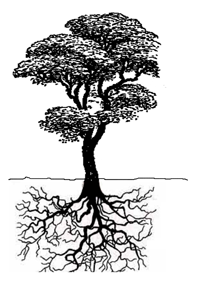 In the vegetal domain, the tree lends itself to a spatially differentiable hierarchy by the levels of the R.E.T.:
In the vegetal domain, the tree lends itself to a spatially differentiable hierarchy by the levels of the R.E.T.:
▶ Pluto: the roots
▶ Mars: the trunk
▶ Sun: leaves, flowers
▶ Moon: fruits and seeds
The plant diversifies the universal as a personal hierarchy changes that of the R.E.T. No tree resembles the typical tree (diversity of shapes and dimensions for trunks, roots, leaves, fruits).
In the animal domain, the axis of powers (central column) becomes undulating, moving, mobile. With a predominantly horizontal structure in most animals… our hominid ancestors would have acquired or conquered by chance the vertical structure. It brings us closer to heaven… in thought. This is perhaps, in fact, a major acquisition that I paid for the benefit of the planetary gravities, discrete forces edifying the skeleton, this tree of the spirit…
And, in the celestial domain, the axis of powers appears with the distances (L) and average planetary gravities (g) treated as simple pendulums (L/g ratios). Thus, on the positive side, power would have the gift of raising, building, structuring… if it is coherent, homogeneous, ordered with its allies. A head without a backbone has no more uplifting power than a heart without head or tail. The stature of a chief is held upright by his skeleton.
Review “Diogenes” of October-December 1992, published a text by Hélène Legendre-De Koninck: “Space, light, sun: the figures of flight.” A very nice article on the myth, the symbolism of the Bird, the Man-Bird and all that the flight of aspiration to the Solar power implies… power of light, of elevation, of gaze on the All by the eye which, intimately united to the body, communicates vision to it, the transparent communion with the world through the flow of perceived light.
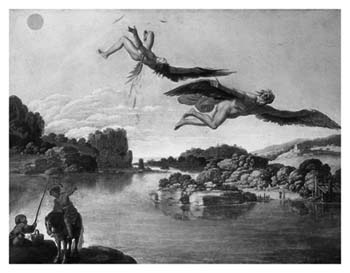 “At the top of the flight: the sun”, writes the author. And, quoting Jules Michelet: “It is in the best age, […] that sometimes man has the good fortune to forget that he is man, serf of gravity and bound to the earth. Here he is taking off, he is hovering, he dominates the world, he swims in a line of the sun, he enjoys the immense happiness of embracing the infinity of things with a glance.” (J. Michelet, L’Oiseau, Paris, Hachette 1856).
“At the top of the flight: the sun”, writes the author. And, quoting Jules Michelet: “It is in the best age, […] that sometimes man has the good fortune to forget that he is man, serf of gravity and bound to the earth. Here he is taking off, he is hovering, he dominates the world, he swims in a line of the sun, he enjoys the immense happiness of embracing the infinity of things with a glance.” (J. Michelet, L’Oiseau, Paris, Hachette 1856).
Incomplete happiness, if one forgets “that we reason all the better about abstract problems if we represent them visually” (Michel Denis, Le cerveau et l’intelligence. Science & Vie special issue of December 1991).
But the vision of the world, whether that of Man or Bird, does not pass through a single eye. The symbolism has indeed planned to grant the Moon to the left eye but hardly mentions it… as if the gaze were enough to unite the Queen and the King, the left and the right, the intensive and extensive powers. United, they make all fragmentary approaches to the real sterile, because reality is not fragmented. Science succeeded in breaking the atom because contrary to what was conceived, it is not the part that is indivisible but the Whole.
1) — If you may be interested, this is Mme Solange de Mailly-Nesle. In Astrologie passion, a collective work under the direction of Élizabeth Teissier (who organizes seminars all over the world), she is presented as the creative astrologer of the Group of Psychoprofessional Astrologers who teach an astrology that is both symbolic and integrated into the reality of the 20th century.
▶ Despite our numerous publications, the renown given to it by the notorious commitment of Françoise Hardy, in the eyes of Madame de Circonstance, in this reality of the 20th century there is no place for conditionalism… hence the care, infinitely maternal, that she has taken, for more than a dozen years, never to talk about it.
▶ Probably because we do not work in the “psychoprofessional” or because she has visceral reasons that fundamentally escape me. Would it not be, in all good, all honour, revenge from Hecate, the hard buttocks of the Black Moon?
▶ I don’t know… but I see that in the work of Elisabeth Tessier, Solange de Mailly-Nesle ends her article “Astrology in the face of science” by the diagram of R.E.T.… without citation of the creator of the registered model (protected from the ethics of astrologers) after a text that goes exactly the opposite of the illustration.
▶ Provocation by the author or his directing supervision… If Madame Solange de Mailly-Nesle is not in question by the intention, I invite her to meditate on the concept of integration, created by conditionalism to understand that it is not only symbolism and censorship that decides the history of astrology.
2) — I do not oppose, as is commonly done, logical thought to analogy, implying, according to the camp where one is placed, that one of the two is superior to the other. other. Logical thinking has its successes and its errors, it is old or new, specific to its time or not. A dynamic analogical thought should adapt to its time and, in ours, the concept of “center” has evolved considerably. When I identify Mars to “center of centers” and the spirituality of “Hara” (see “Astrologie et spiritualité”, page 134), it is not a question of an organic and static localization (the belly) but of a center of gravity, and the L/g ratio which places Mars at the center of the R.E.T. couples, is concrete by its data, abstracted by its result.
3) — But, since the centers communicate to form an axis, and because of the interferences between the universal hierarchy and the personal hierarchy, one can be directed by the heart, by love, hate, as by sex or interest. It is perhaps the planet in position No. 1 which gives this solar indication.
▶ This affair of the heart recalls the shameless affectation of the “big R” to affectivity. As far as the planets are concerned, the conditionalist teaching rests on the Theory of Ages and the Logoscope, parent matrix of R.E.T. The theory of ages is chronological (time referential), the R.E.T. is not (Structure repository). These are distinct repositories that the oldest myths have tried to bring together and not to confuse.
On the mathematical level, I have combined the chronological (increasing values of the planetary cycles linked to the semi-major axes) and the timeless (values of the semi-major axes/average gravity ratios) in a single formula (page 120 of the Éléments de Cosmogonie Astrologique).
On the level of discourse, I have often dealt with the interaction of “chronological and simultaneous”… the simultaneous being the set of planets, it is easy to convert it into R.E.T. If this set did not act in a non-chronological way, the child born under a uranian dominant, would wait to be an adult to show the features… and those or Pluto, “small t” is in question would only demonstrate critical judgment between the ages of 164 and 250.
The human being is affective from his gestation to his death and beyond if the other world exists, but over time, he loses this affectivity, he becomes cerebral or hardens. From flesh, he becomes a skeleton and death sends us back to the timeless, to the structure.
Therefore, if the first age makes us live the “R” more affectively than in the second, third or last, it is not because of the “big R affective” planets but because of the human baggage. From year to year, until the last, they will not restore the love of the child of 1 year, but the permanence of the extensive Representation. At 20, 30, 40, 50, it lives with the means of the moment (structure-time interference).
let’s compare chronological order to the structural order of R.E.T. At 1 year old, the child has lived through the Moon, Mercury, Venus, Sun stages… so, the Moon and the “big R” family, but not in the order of this family which is Sun, Venus, Mercury… Huge distortion which excludes the identification of the solar stage with the integration of the group. Knowing that, in the R.E.T., the planetary functions (and not the ages) are coupled around Mars, so that the chronology recomposes the whole, it is necessary the acquisitions of all the planets of the part “clear” of the R.E.T., i.e., after Mars, reach the age of Jupiter. Despite a chronological distribution different from that of the R.E.T., we then have all the functions to imagine, design, live or symbolize the R.E.T. order. For this, we must abstract ourselves from the chronology. This operation, which is probably done in the axis of powers and its neurobiological correspondences, corresponds to the age of Saturn from which the chronological order (Saturn, Uranus, Neptune, Pluto) is identical to the structural order. Is there a bigger change than that?
We cannot therefore deduce the R.E.T. of the timeline let alone reduce it to it. The process amounts to denying the structure, making R.E.T. a psychology of the ages and, finally, to level off without any kind of demonstration all the originality of conditionalist research on this model. An operation of return to the “Subject” and of denaturation that I denounced to the great agitation of “tolerant” spirits who would have liked the sacrifice of forty years of work to satisfy whimsical drifts.
I remind you that if the R.E.T. came after the theory of ages, it was because I had reduced the chronology to the speed of healing… that is to say to a mathematical function.
Article published in issue No. 18 of the Cahiers conditionalistes (3rd quarter 1993).
▶ The Solar: Psychological profile
▶ Solar stage (from 7 1/2 months to 1 year old): the age of identification
▶ Sun-Mercury-Venus: extensive Representation
▶ Sun-Jupiter-Uranus: intensive representation
▶ Sun-Mars-Pluto: extensive Power
▶ The dialectic of powers in the R.E.T. system
▶ Apollon et son ombre : quand le Soleil se fait violence
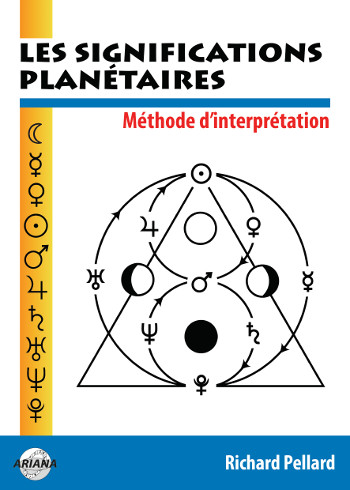
Les significations planétaires
par
620 pages. Illustrations en couleur.
La décision de ne traiter dans ce livre que des significations planétaires ne repose pas sur une sous-estimation du rôle des Signes du zodiaque et des Maisons. Le traditionnel trio Planètes-Zodiaque-Maisons est en effet l’expression d’une structure qui classe ces trois plans selon leur ordre de préséance et dans ce triptyque hiérarchisé, les Planètes occupent le premier rang.
La première partie de ce livre rassemble donc, sous une forme abondamment illustrée de schémas pédagogiques et tableaux explicatifs, une édition originale revue, augmentée et actualisée des textes consacrés aux significations planétaires telles qu’elles ont été définies par l’astrologie conditionaliste et une présentation détaillée des méthodes de hiérarchisation planétaire et d’interprétation accompagnées de nombreux exemples concrets illustrés par des Thèmes de célébrités.
La deuxième partie est consacrée, d’une part à une présentation critique des fondements traditionnels des significations planétaires, d’autre part à une présentation des rapports entre signaux et symboles, astrologie et psychologie. Enfin, la troisième partie présente brièvement les racines astrométriques des significations planétaires… et propose une voie de sortie de l’astrologie pour accéder à une plus vaste dimension noologique et spirituelle qui la prolonge et la contient.
Téléchargez-le dès maintenant dans notre boutique
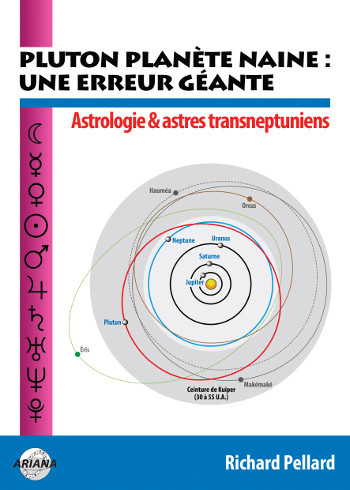
Pluton planète naine : une erreur géante
par
117 pages. Illustrations en couleur.
Pluton ne fait plus partie des planètes majeures de notre système solaire : telle est la décision prise par une infime minorité d’astronomes lors de l’Assemblée Générale de l’Union Astronomique Internationale qui s’est tenue à Prague en août 2006. Elle est reléguée au rang de “planète naine”, au même titre que les nombreux astres découverts au-delà de son orbite.
Ce livre récapitule et analyse en détail le pourquoi et le comment de cette incroyable et irrationnelle décision contestée par de très nombreux astronomes de premier plan. Quelles sont les effets de cette “nanification” de Pluton sur son statut astrologique ? Faut-il remettre en question son influence et ses significations astro-psychologiques qui semblaient avérées depuis sa découverte en 1930 ? Les “plutoniens” ont-ils cessé d’exister depuis cette décision charlatanesque ? Ce livre pose également le problème des astres transplutoniens nouvellement découverts. Quel statut astrologique et quelles influences et significations précises leur accorder ?
Enfin, cet ouvrage propose une vision unitaire du système solaire qui démontre, chiffes et arguments rationnels à l’appui, que Pluton en est toujours un élément essentiel, ce qui est loin d’être le cas pour les autres astres au-delà de son orbite. Après avoir lu ce livre, vous saurez quoi répondre à ceux qui pensent avoir trouvé, avec l’exclusion de Pluton du cortège planétaire traditionnel, un nouvel argument contre l’astrologie !
Téléchargez-le dès maintenant dans notre boutique